2007 VOLKSWAGEN GOLF PLUS ignition
[x] Cancel search: ignitionPage 69 of 541
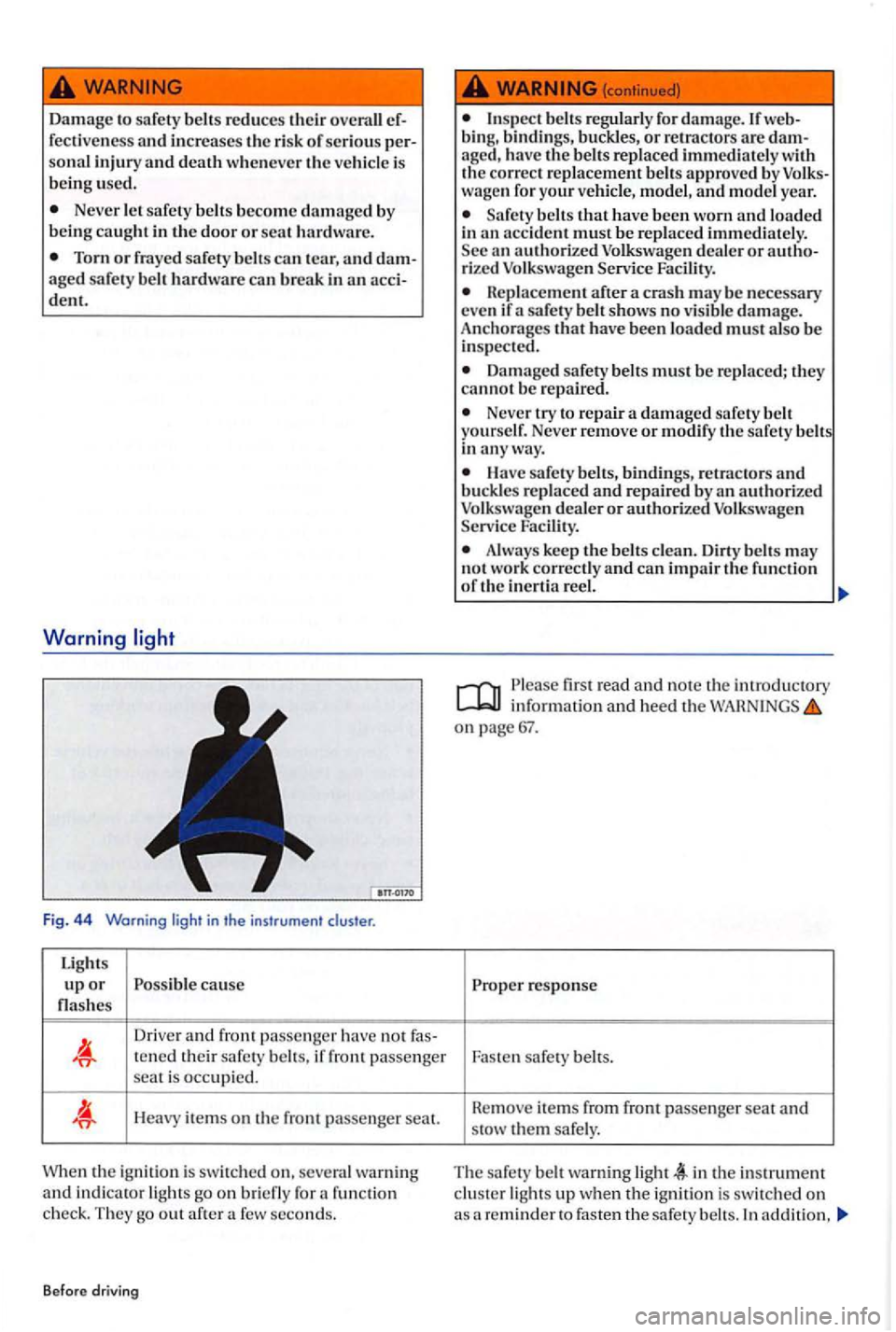
Damage to safety belt s reduces their ef
fectiven ess increase s the ris k of seriou s perinjury is
b ein g used.
Neve r safety belt s beco me damage d by
b ei ng caught in the door or seat hardware.
Torn or frayed safety te ar, and dam
aged safety hardware break in accident.
Warn ing
Fig. 44 Warning
Light s
u p o r cause
Driver and fron t pa sse nger have not fas-te n ed their safety if fron t passenger
sea t is occupied.
H eavy items on the front passenger seal.
the ignition is switched on. warning and in dica tor go on fun ction c he ck. They out after few seconds.
Before driving
for damage. If web
bin g, bindings, or re tra cto rs are damaged, have the approve d by wage n for your and year .
Safety that have bee n worn and in an accide nt must be
after a cras h may be nece ssary
eve n if safety sho ws no damage.
Anchorages that have been must
Damage d safety the y canno t b e re p air ed.
Neve r try to re pair a damage d sa fety Never remove or m odify th e safety
Have sa fety belts, binding s, retractor s and
or authorized Serv ice
k ee p the may
n ot work correct ly and ca n impair the function
o f th e in erti a
firs t rea d and note the introductory information and heed the on page 67.
Proper respo nse
Faste n safe ty
T he safety warning in the instrument
In add ition,
Page 70 of 541
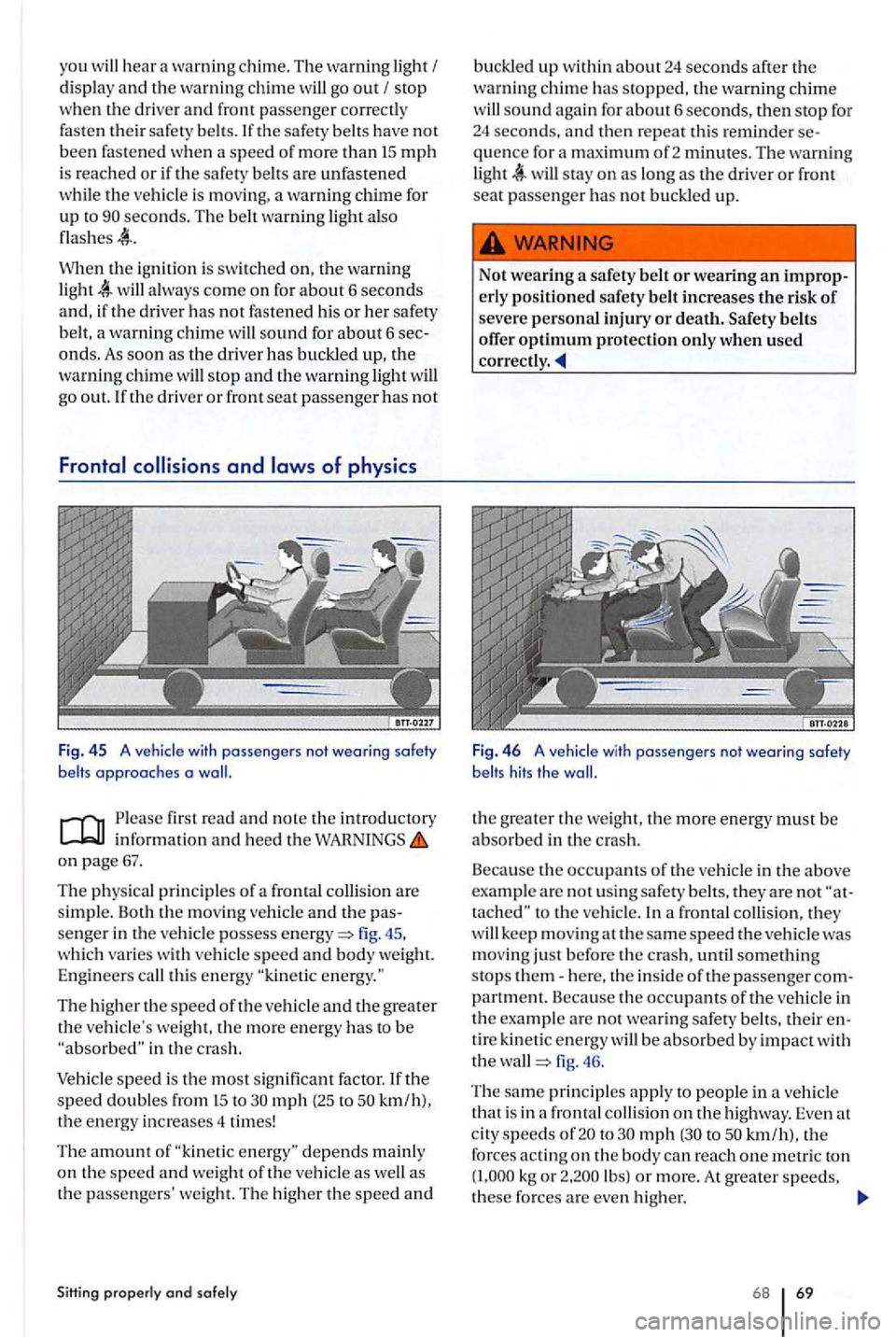
you hear a warn ing chime. The warning light stop
when the driver and front passenger correctly fas ten their sa fety belts. If the safety belts have not been fastened when a speed of more than 15 mph is reached or if the safety be lts are unfastened
while the vehicle is moving , a warning chime for
up to seco nds. The belt warning light also
When the ignition is sw itched on, the warning
and of phy sic s
Fig. 4 5 A vehicle with passengers not wearing safety belts approaches a
on page 67.
The physical principles of a frontal
fig . 45.
which varies wit h vehicle speed and body weight.
Engineer s
The higher the speed of the ve hicle and the greater
the vehicle's weight. the more en ergy has to be in the cras h.
Vehicle speed i s th e most sig nificant factor. If the speed doubl es from to mph (25 to kmlh),
the energy increases 4 times!
The amount of as
the passengers' weight. The higher the speed an d
Sitting properly and solely
buckled up within about24 seconds after the
warn ing chim e has stopped, the warnin g chime sound again for about 6 seco nds, then stop for 24 seconds, and then rep eat this reminder sequence for a
Fig. 4 6 A vehicle with passengers not wearing safety
belts hits the
the greater the we ig ht, the more energy must be abso rbed in the crash.
Beca use the occupants of th e vehicle in the above
example a re not usi ng safety belts, they are not
kee p m oving at the same speed the vehicle was
mo vin g just before the crash, until somethin g
stops th em-here, the inside of the passenger com
partment. Because the occupants of the vehicle in
th e exa mpl e are not wearing safety belt s, th eir en
tire kine
tic energy be absorbed by impact with
the fig. 46.
Th e
same pri ncipl es app ly to p eople in a veh icle
th at is in a fron ta l
to mph to kmlh), the forces acting on th e bod y can reach one metri c ton kg o r lbs) or more. At grea te r speeds,
th ese forces are even hi ghe r.
68 69
Page 83 of 541
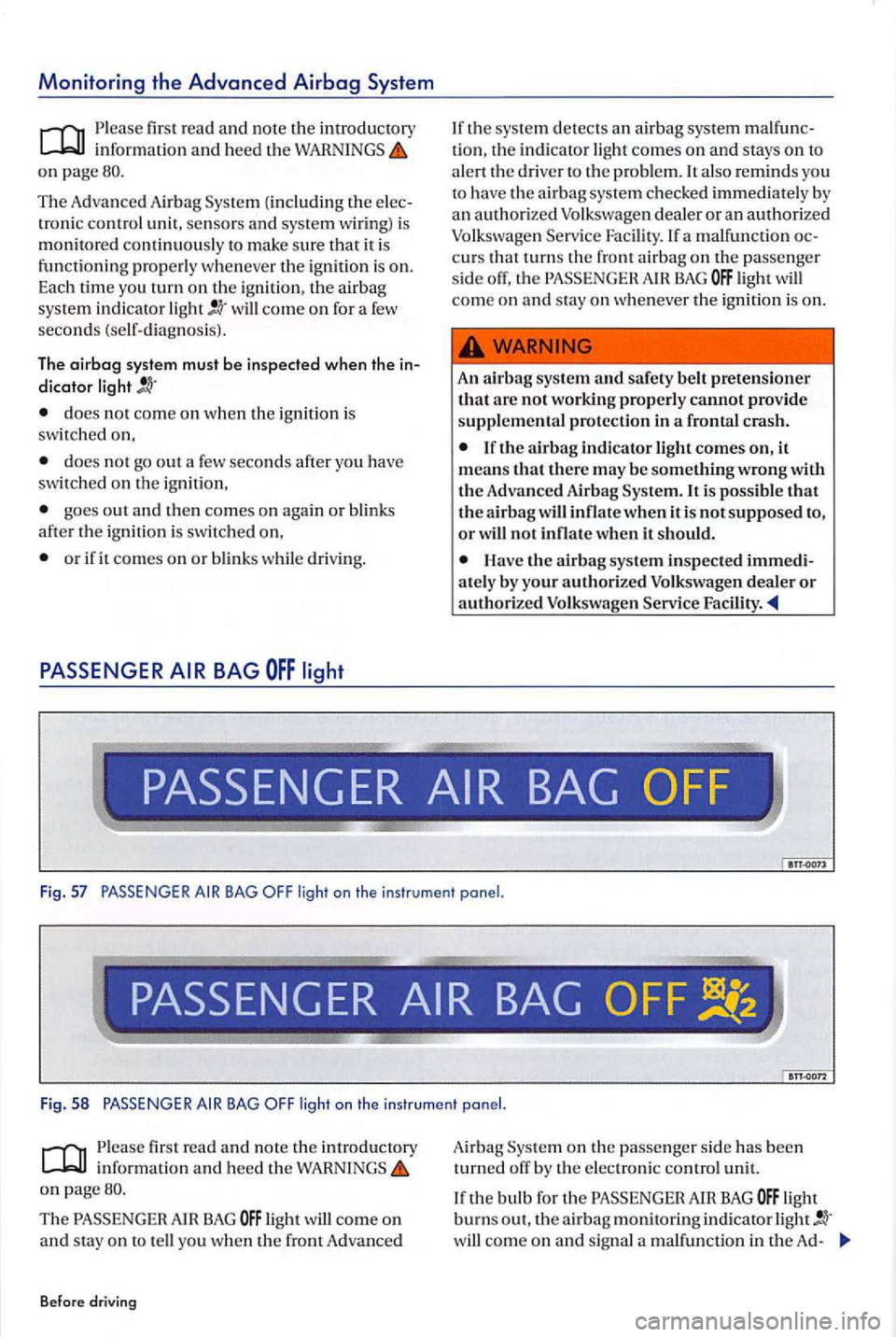
Monitoring the Advanced Airbag System
Please rea d and no te the introductory
on page80.
T he A dva n
ced Airb ag (including the e lec
troni c control unit , sensors and sys te m wiring ) is monitore d continu ously to make sure that it is
functioning properly when ever the ig nition is on. Each time you on th e ig nition , the airbag
system indicator light will come on fo r a few
seconds (se lf-d iag nosis).
The airbag system must be inspected when the indicator light
does not come on when th e ignition is swi tched on,
does n ot go out a few seconds after you have switch ed on th e ignition,
goe s out and th en comes o n again or blink s afte r th e ig n ition i s switch ed on,
o r if it comes on or blink s while dri ving.
PASSENGER
If th e sys te m d etec ts a irba g sys te m m alfun c
ti on , th e indi cator lig ht comes on and stays on to
a le n th e dri ver to th e prob le m. I also reminds yo u
to have the a irbagsys te m checke d immediat ely by an authoriz ed Volk sw agen dealer or an auth ori zed Volkswa gen Facility. !fa malfunction oc
c ur s that turns the front a irbag on th e passenger
s ide off, th e BAG
not inflate when it should.
Ha ve the airbag system inspected immediately by your authorized Volkswagen dealer or authorize d Volkswagen
Fig . 57 light on the instrum ent
PASSENGER
Fig. 5 8 BAG lig ht on the in strume nt
Plea se first rea d and note the introducto ry
on page
The
on th e passenger sid e has been turned off by th e e lec tronic control unit.
If th e bulb for the
ligh t burns out, the a irbag monitoring indicator will come on and signa l a m alfun ction in th e Ad-
Page 98 of 541

door and the backre st. T he general locatio n is
s hown b y th e The area s marked in (dotted lin es)=> 62 in dicate the deploy
m ent zones of the s ide airbags.
Durin g a s ide colli sio n , the sid e airbags in the backres t ca n deploy. there by redu cing th e risk of inju ry to ve hicle occupants.
The side airbag system includes :
ele ctroni c control m odule and side impact sensors .
Sid e ai rbags in the fro nt backrests and , where applicable, sid e airbags in the rear backrests .
An airb ag monito rin g sy ste m an d indicator light in the in strumen t clu ste r
W hen a side a irbag deploys in a coll is io n, a gas gene ra tor the side airbag b etween the vehicle occupant and the door. Th e side airbag syste m
supple m ents th e safety belt s and ca n help toreduce the ris k of injury to the occupants' upper torso .
In ord er to help pro v
ide this additio nal protection, the sid e airbag must infl ate w ithin the bl ink of an eye at very hi gh sp ee d and w ith great force. The supplemental side a irbag co uld injure yo u if your seating position is not proper or upright or ifitems are in the area where the supplemental sid e airbag inflate s. Thi s applies especiall y to children
w ill co m e on for a few seconds
(self- d iagnos is).
The airbag syste m i s no t a s ubstitute for your safety be lt. Rather, it is part of the ov era ll occ upant restra int system in your ve hicle=> page 56,
re ad y dep lo ye d.
properly and safe ly
The side airbag sys tem
if the ignition i s sw itched ofT wh en a crash occurs,
in side c o lli sio ns wh en the a cce le rat ion mea
s u re d b y the sensor is to o low,
in front-end collis ion s,
in re a r-end collis ion s,
in rollovers, unless the depl oy men t threshold for deploym ent stored in the control unit is met.
I n s
ome ty pes of accid ent s the front airbags , Sid e
C urtain airbag s and sid e airb ags may
b e triggered together.
A n Inflatin g side a irbag can cause serious or even fatal injury. Improp erly wearing safet y
b elt s and improp er seatin g po siti ons increase
th e risk of se riou s persona l injury and death
whenever vehicle is being used.
To help reduce the risk of injury when the
supplemental sid e a irb ag inflat es,
- Always sit in
an upright po sition and do
not l ea n agai nst th e area where the s ide
airbag is located.
- Neve r le t a c hild or anyo ne e lse rest their
head again st th e s ide trim panel in the area
where the s ide ai rbag inflates.
- Never let anyo ne s itting in the front
seat put their hand out o f window.
betw een yo u and the airba g ca n in
crease the risk of injury in a colli sion by inter
fering with the way the airbag unfolds or by
being pushed into you as th e airbag inflates.
Never pla ce or attach a ccess ories or other ob
je cts (su ch a s cup holders, telephone bracke ts , or eve n large , bulky objects) on the doors or over or ncar th e area mark ed p age 96, fig. 6 1.
Accessories or other object s ca n fly dangerously
throu gh the passe nger compart ment and cau se serio u s injury if the supplemental sid e airbag
Neve r position or hol d any obje cts o r pet s in the
deplo yment space of an airbag or allow any child
r e n or other passenge rs to trave l in s uch a pos ition .
Never use th e built -in coat hook s for any thin g but lightweig ht clothing . Neve r leave
any heavy or sharp- edged objects in the pockets. objects may interfere w ith side airbag de
pl oy ment and cau se seriou s personal injury in a
co llisio n.
96 97
Page 108 of 541

-Always make sure that the forward-facing seat has been designed and certified by its manufacturer for use on a front passenge r seat with a front and side airbag.
- Always carefully follow the
turer's instructions provided with the child seat or carrier.
- Never install a child restraint without a
properly attached top
tether strap if th e child
restraint manufacturer's instructions quire the top tether strap to be used.
- Never
put the forward-facing child
ment panel.
- Always set
the safety belt upper anchorage to the adjustment position that permits proper installation in accordance with tl1e child restraint manufacturer's instructions.
- Always move the
passenger seat to the high est position in the up and down
straint.
- Always make sure
that nothing prevents the front passen ge r's seat from being moved
to the rearmost position in its fore and aft
-Always make sure that the backrest is in the upright position.
- Never place additional
item s on th e seat that can increase the total weight registered
by the weight-sensing mat and ca use injury
in a crash.
Always buckle the child seat firmly in place
eve n if a
Alway s read and heed aU WARNINGS eve r using a child restraint in a vehicle page
light
comes on and stays on whenever a child straint is installed on tl1e front passenger seat and the ignition is switched on.
AIR BAG
page82.
the off senger seat and install it properly at one of the rear seating positions if the
Have the airbag system inspected by your authorized Volkswagen dealer or aulhorized Volkswagen Service Facility immediat ely .
Page 114 of 541
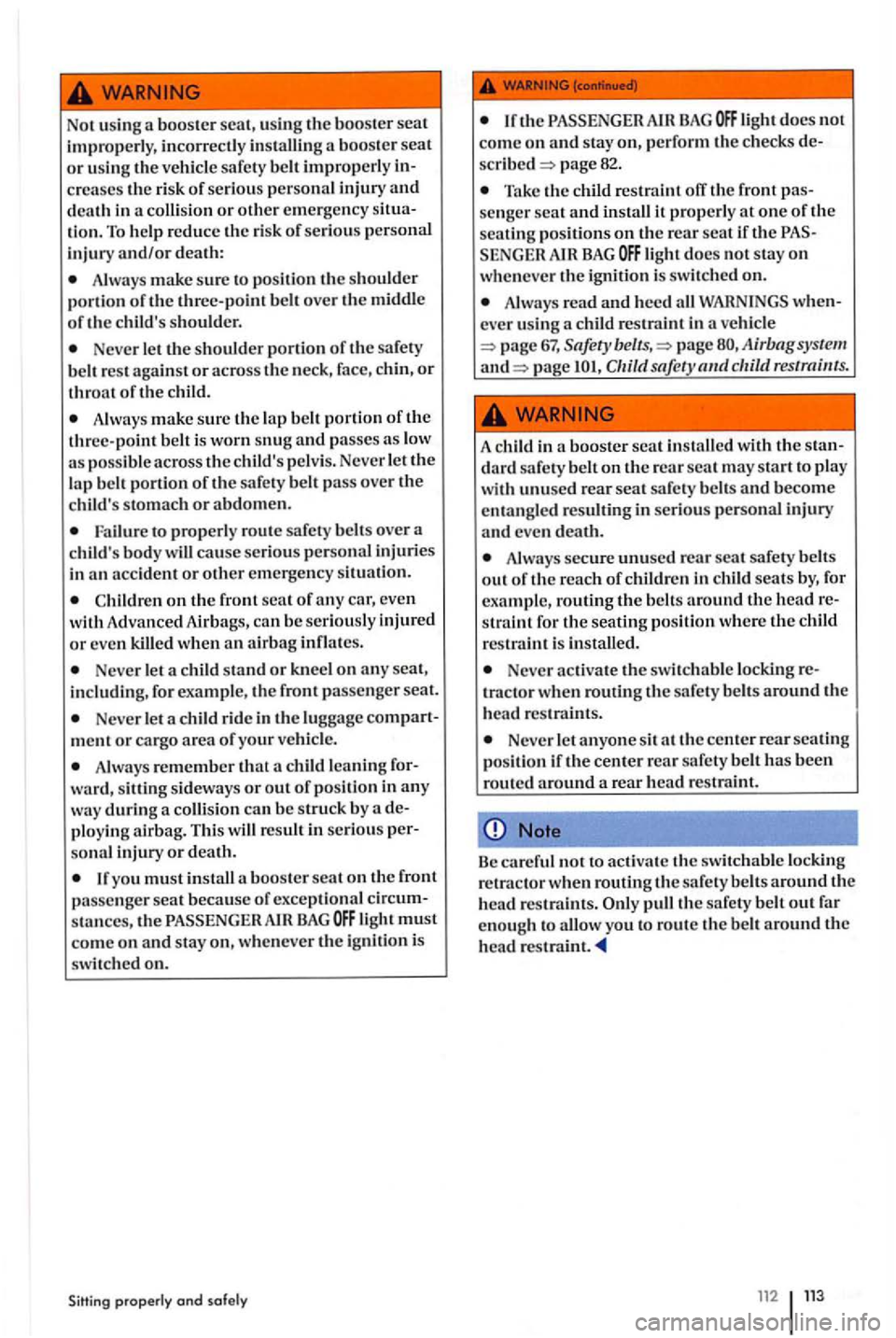
Not usin g a booster scat, u sing the boos ter sca t improperly, incorrect ly instal.ling a booster seat or usin g the ve hicl e safety belt improp er ly c reases the risk of seriou s personal injury and death in a collision or other emergen cy
A lways make sure to po sition the s houlder
p o rtion of the three-point belt over the middl e of the c hild 's should er.
Never let th e s houlder portion of the safety belt rest aga inst or across the neck, face, chin, or
throat of the ch ild.
Always make sure the lap belt portion of the
three-point belt is worn snug and pa sses as low po ssible across the child's pel vis. Never le t the
lap belt portio n of the safety belt pass over the
child's stomach or abdomen.
Failure to prop erl y rou te safety belts over a
c hild's body will cause serious perso nal in juri es
in an accident or ot her em erge ncy situ ation.
on the front seat of a ny ca r, eve n
with Advanced Airbags, can
Never le t a child stand or kneel on any sea t,
including , for example, the front passenger seat.
Neve r let a child ride in the lug gage ment or cargo area of your vehicle.
Always remember that a child leaning ward, sitting sideways or out of po sition in any
way during a co llision can be struck by a ploying airbag. This will result in seriou s
you must install a booster seat o n th e front
pa sse nge r scat b eca use of exceptional stances, the AIR BAG
BAG
page 82.
Take the ch ild restraint orr the front se nger sca t a nd install it properl y at o ne of the sea ting position s on the rear scat if the ligh t docs not stay on whe neve r the ignition is swit ch ed on.
rea d and heed all ever usi ng a child restraint in a vehicle page pa ge
A child in booster seat in stalled with th e
Alwa ys sec ure unused rear sca t safety belts
o ut of th e reach of child ren in child seats by , for
exa mple , routing the belt s a round the hea d
Neve r activa te the sw itchablc locking tractor when routing the safet y belt s around th e
h ead re straints.
Neve r le t anyo ne si t a t th e center rear seating
po sition if the center rear safety belt has been routed around a rear head restraint.
No te
Be care ful not to activate the switc h abl e loc kin g
retra ctor wh en routing the safe ty belt s around the
head restraints. pull the safe ty belt out fa r
eno ug h to allo w yo u to route th e be lt around t11e head restra int.
Page 124 of 541
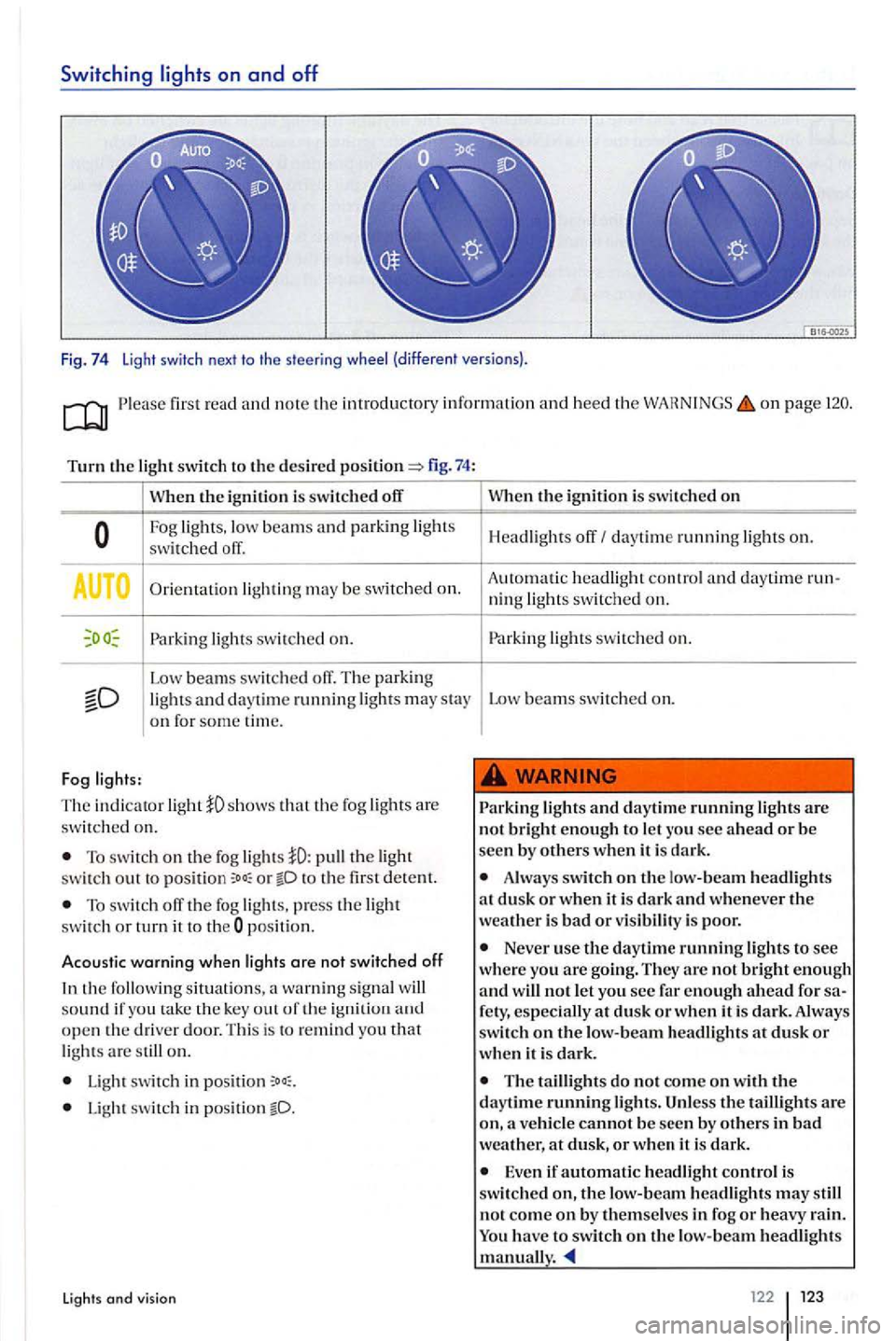
Switching lights on and off
Fig. 74 Light switch next to the steeri ng (different versions).
first read and note the introducto ty information and heed the o n page
Turn the switch to the desired fig . 74:
When t11e ignition is swit ch ed off
Fog lights,
Orientation light ing may be switched on.
light s sw itched on.
--Low beam s swi tc h ed off. T he park ing and day tim e runnin g light s may stay on for some time.
Fog
The indicator light
To switch on the fog the swi tc h out to o r to the first detent.
T o switch th e fog lights, press the ligh t switch or turn it to t he pos ition.
Acoustic warning when lights are not switched off
the following situati on s, a wa rnin g sig nal sound if you take the k ey out o f th e op en th e driver door. This is to remind you that lights are on.
Light switch in
Light switch in position
Lights and vision
t11c ignition is swi tched on
Headligh ts daytim e running on.
A ut
omatic headligh t and daytime ning lights sw itched on.
switched on.
Low beams switched on.
lights and daytime running lights are not bright enough to let
Always switch on t11e lo w-beam headlights at dus k or when it is dark and whenever weather is bad or visibility is poor.
Never use the daytime running lights to see where you are going. They are not bright enough and will not let you see far enough ahead for
The taillight s do not come on t11e daytime running light s. the taillight s are on,
Even if automatic headlig h t control is switched on, the headlights may st ill
not come on by themsel ves in fog or heavy rain. have to switch on the low-beam headlights manual!.
122 123
Page 129 of 541

In this section you'll find information on th e lowing:
Indicator light . . . . . . . . . . . . . . . . . . . . . . . . . . . . . . 128
func tions . . . . . . . . . . . . . . . . . . . . . . . . . . . . .
w iper service pos itio n . . . . . . . . . . . .
Rain sensor . . . . . . . . . . . . . . . . . . . . . . . . . . . . . . . . . 131
and refilling wind shi eld washer fluid 132
More information :
Air condition er air rec irculation mode page 226
Preparatio ns for working in the engin e page 242
Exte rior care and cleaning=> pag e 262
washer fluid without enough frost can freeze on the windshield and duce visibility.
Never use the wind shield wipers/washers when it is freezing without first defrosting the windshield. The washer solution may freeze on the windshie ld and reduce visibility.
sonal injury.
Always replac e wiper blades that are worn,
damaged, or do not kee p the windshield clear.
Note
To help prevent damage to the wiper blades and the wiper motor when it is cold outside, always make sure that blades are not frozen to the shi eld before operating the wipers. When parking the vehicle in freezing weather, it can be he lpful to
plac e th e windshield wipers in the so they do not fr eeze to the windshie ld
Plea se first read and note th e imrodu cto ry informati on and hee d the on page 128.
Light s up Possibl e ca use
was her and re ar windo w
was he r fluid leve l too low.
the ignition is switc h ed Note
Failure to heed warning ligh ts or text can resu lt in ve hicl e damage